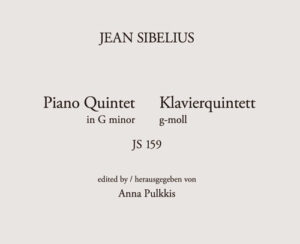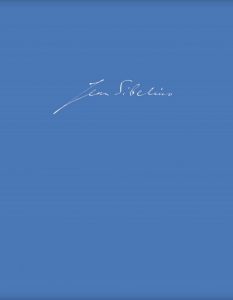Piano Quintet in G minor, JS 159
Complete Works (JSW), edited by the National Library of Finland
and the Sibelius Society of Finland
Series IV (Chamber Music) Volume 3
Edited by Anna Pulkkis
SON 637 – € 238.00
220 pages – ISMN: 979-0-004-80392-9
Having previously issued major chamber works including the string quartets and piano trios, the JSW edition has now reached the most ambitious of all Sibelius’s chamber compositions: the five-movement Piano Quintet in G minor, a piece that is longer than some of his symphonies and represents the springboard from which he launched himself into a career as an orchestral composer. Also included is a previously unpublished Vivace movement, an alternative version of the Quintet’s scherzo, and (in facsimile form) a separate if sizeable fragment, Andante – Allegro in F sharp minor for piano quintet (JS 31) that dates from 1888–89, a year or so before the principal work here.
The Quintet dates from the spring of 1890 and is the only major work he wrote while he was studying under Albert Becker in Berlin. A possible inspiration was Sinding’s Piano Quintet in E minor, Op. 5 (1882–84), which Sibelius travelled to Leipzig to hear in January 1890.
The first and third movements were played in Helsinki in May 1890, but Sibelius was not present. The pianist on that occasion was Ferruccio Busoni, who had also played in the Leipzig performance of Sinding’s Quintet that Sibelius had attended and who this played an important role in the history of Sibelius’s piece. The first four movements were played in Turku that October, again without the composer in attendance, but there was no complete public performance in Sibelius’s lifetime – in fact not until 1965, the centenary of his birth; that concert also took place in Turku. Although the score of the Quintet remained at his home, Ainola, during the later years of Sibelius’s life, he was apparently unaware of its whereabouts; this at least saved it from the flames that (presumably) consumed the Eighth Symphony. It was first published by Edition Wilhelm Hansen in 1993.
Unusually for Sibelius, several of the themes from the Piano Quintet found their way into other compositions. An idea from the end of the finale (bar 282 ff.) was transformed into the first of the Six Impromptus for piano, Op. 5 (1893), whilst the main theme of that movement was used in a Rondo for viola and piano from the same year (JS 162). It is surely no coincidence that both of these themes come from the one movement that had been omitted from both the public performances in 1890. Presumably Sibelius recognized the merits of the themes in question and was keen not to let them go to waste.
Right from the outset it is evident that in the Piano Quintet Sibelius was aiming for a tougher, more sombre atmosphere than in most of his earlier chamber music; this mood is maintained through the sonata-form first movement. His former teacher Martin Wegelius had reservations about this movement (‘clumsy’ […] ‘highly awkward passages’). The Intermezzo that follows is much more relaxed in mood, with songful melodies and more than a touch of Finnish melancholy. This vein is even more prominent in the hymn-like main theme of the slow movement – an idea to which the composer returned some fifty years later, around 1940, in sketches for a piece that was never completed, the chorale, O Herra, siunaa (O Lord, bless). The relatively brief scherzo is restless and mercurial; its trio section is dominated by a broad, lilting melody. The finale is generous with its thematic material, and is often very exciting with sul ponticello effects, furious piano semiquaver runs and dramatic silences.
The alternative scherzo movement included in the present volume is wholly different from the movement that Sibelius eventually chose; it is a good-humoured, extrovert piece with memorable, attractive themes that are passed between the instruments with great skill. Sibelius’s reasons for replacing this movement with a shorter and more acerbic alternative must remain a subject for conjecture although it should be noted that the death of his beloved Uncle Pehr (‘my Pappa’s substitute here on the earth’) on 4 January 1890 may have affected his mood.
As always in the JSW series, this is a handsomely produced volume with a detailed introductory essay (by Anna Pulkkis, who edited these pieces), numerous pages of manuscript facsimiles and a thorough critical commentary including full source information.
Review by Andrew Barnett and Ian Maxwell
Review copy kindly supplied by Breitkopf & Härtel
To order this volume, click here.

